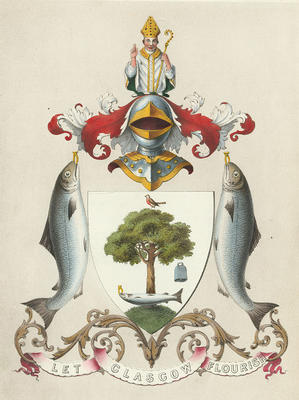
The coat of arms of the City of Glasgow, as granted by the Lord Lyon in 1866. It incorporates a number of symbols and emblems associated with the life of Glasgow's patron saint, Kentigern (often known by his nickname, Mungo) which had been used on official seals prior to that date.
The oak tree, with Kentigern's bell hanging from it, refers to a fire which Kentigern started using one of its branches. Perched on top of it is a robin which was a favourite of young Kentigern's tutor Saint Serf and which Kentigern brought back to life after jealous fellow pupils had killed it.
The fish is a salmon, caught in the River Clyde by one of Kentigern's monks. The King of Strathclyde Rydderach Hael had given a ring to his queen Langeoreth, who had then given it to her lover. Rydderach Hael discovered he had been cuckolded and had the ring thrown into the Clyde, then demanded that his wife come to court wearing it. He hoped to humiliate her by showing that he knew of her infidelity, but Langeoreth confessed to Kentigern and he promised to help her. He ordered a monk to catch a salmon, and when the ring was found in its stomach, Langeorath was able display it on her finger. It is said (but not fully explained!) that the king was mollified and that the couple lived happily ever after.
Kentigern is also said to have preached the sermon containing the words "Lord, let Glasgow flourish by the preaching of the word." This was abbreviated to "Let Glasgow Flourish" and adopted as the city's motto.
Reference: Mitchell Library, G 929.8 MCG
Reproduced with the permission of Glasgow City Council, Libraries Information and Learning
Keywords:
bells, birds, bishops, coats of arms, emblems, fish, Glasgow coat of arms, heraldry, kings, legends, Lord Lyon, mottoes, oak trees, queens, rings, River Clyde, robins, salmon, symbols
You have 1 image in your photo album.